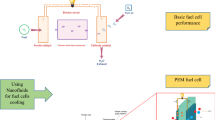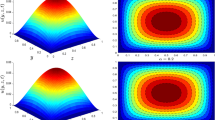Abstract
In this numerical study, the variations in the surface area of the cooling channels in a solid oxide fuel cell with different cross sections and multi-walled carbon nanotubes oil/MWCNT nanofluid volume fractions are considered. Rectangular, trapezoidal and elliptical cross sections, and nanofluid volume fractions of 0–6% for the fluid are chosen as the studied parameters as well as the mass flow rates. In this research, a 3D model is developed by the finite volume method using the computational fluid dynamics (CFD). Then, the flow field and the heat transfer rate are predicted. The results show that the dissipated heat in the fuel cell is dependent on the mass flow rate of the fluid. That increased heat increases the heat transfer rate. The presence of the solid particles can also reinforce the heat conduction of the coolant fluid and consequently improve the heat transfer performance. The pumping power is maximum for the highest mass flow rate and the highest solid nanoparticle volume fractions. Additionally, the pumping power is dependent on the route in which the sections with lowest momentum changes and lowest pressure drops have the least amount of the pumping power. The ratio of the dissipated heat by the nanofluid over the base fluid is compared to a pressure drop. The movement of flow with the lower mass flow rates will result in penetrations of the thermal boundary layers into different flow regions, which can increase the optimum temperature in the solid part of the fuel cell. By increasing the mass flow rate of the fluid passing through the channels from 0.002 to 0.004 kg s−1, the maximum temperature is decreased by 6.13, 3.34 and 6.35% for rectangular, trapezoidal and elliptical channels, respectively.









Similar content being viewed by others
Abbreviations
- \(C_{\text{p}}\) :
-
Specific heat (J kg−1 K−1)
- \(K\) :
-
Thermal conductivity for fluid (W m−1 K−1)
- \(L\) :
-
Length (mm)
- \(P\) :
-
Pressure (Pa)
- \(Q\) :
-
Heat transfer rate (w)
- \(T\) :
-
Temperature (K)
- \(W\) :
-
Width (mm)
- \(W_{\text{pump}}\) :
-
Pumping power
- \(u, v, w\) :
-
Velocity (m s−1)
- \(\mu\) :
-
Dynamic viscosity (N s m−2)
- \(\rho\) :
-
Density (kg m−3)
- \(\vartheta\) :
-
Kinematic viscosity (m2 s−1)
- \(\Delta P\) :
-
Pressure drop (Pa)
- \(\dot{Q}\) :
-
Volumetric flow rate (m3 s−1)
- a:
-
Anode
- c:
-
Cathode
- ch:
-
Channel
- e:
-
Electrolyte
- f:
-
Fluid
- fc:
-
Fuel cell
- In:
-
Inlet
- nf:
-
Nanofluid
- out:
-
Outlet
- s:
-
Solid
References
Ershadi H, Karimipour A. Present a multi-criteria modeling and optimization (energy, economic and environmental) approach of industrial combined cooling heating and power (CCHP) generation systems using the genetic algorithm, case study: a tile factory. Energy. 2018;149:286–95. https://doi.org/10.1016/j.energy.2018.02.034.
Khodabandeh E, Safaei MR, Akbari S, Akbari OA, Alrashed AAAA. Application of nanofluid to improve the thermal performance of horizontal spiral coil utilized in solar ponds: geometric study. Renew Energy. 2018;122:1–16. https://doi.org/10.1016/j.renene.2018.01.023.
Toghraie D, Karami A, Afrand M, Karimipour A. Effects of geometric parameters on the performance of solar chimney power plants. Energy. 2018;162:1052–61. https://doi.org/10.1016/j.energy.2018.08.086.
Qin Y, Liu G, Chang Y, Du Q. Modeling and design of PEM fuel cell stack based on a flow network method. Appl Therm Eng. 2018;144:411–23. https://doi.org/10.1016/j.applthermaleng.2018.08.050.
Kurnia JC, Sasmito AP, Shamim T. Performance evaluation of a PEM fuel cell stack with variable inlet flows under simulated driving cycle conditions. Appl Energy. 2017;206:751–64. https://doi.org/10.1016/j.apenergy.2017.08.224.
Milewski J, Szczęśniak A, Szablowski L. A discussion on mathematical models of proton conducting solid oxide fuel cells. Int J Hydrog Energy. 2019;44(21):10925–32. https://doi.org/10.1016/j.ijhydene.2019.02.082.
Miao H, Chen B, Wu X, Wang Q, Lin P, Wang J, et al. Optimizing strontium titanate anode in solid oxide fuel cells by ytterbium doping. Int J Hydrog Energy. 2019;44(26):13728–36. https://doi.org/10.1016/j.ijhydene.2019.03.111.
Zhang G, Kandlikar SG. A critical review of cooling techniques in proton exchange membrane fuel cell stacks. Int J Hydrog Energy. 2012;37(3):2412–29. https://doi.org/10.1016/j.ijhydene.2011.11.010.
Chen H, Pei P, Song M. Lifetime prediction and the economic lifetime of proton exchange membrane fuel cells. Appl Energy. 2015;142:154–63. https://doi.org/10.1016/j.apenergy.2014.12.062.
Atan R, Wan WM. Temperature profiles of an air-cooled pem fuel cell stack under active and passive cooling operation. Procedia Eng. 2012;41:1735–42. https://doi.org/10.1016/j.proeng.2012.07.376.
Cao T-F, Lin H, Chen L, He Y-L, Tao W-Q. Numerical investigation of the coupled water and thermal management in PEM fuel cell. Appl Energy. 2013;112:1115–25. https://doi.org/10.1016/j.apenergy.2013.02.031.
Akbari M, Tamayol A, Bahrami M. Thermal assessment of convective heat transfer in air- cooled PEMFC stacks: an experimental study. Energy Procedia. 2012;29:1–11. https://doi.org/10.1016/j.egypro.2012.09.002.
Mench MM, Chao-Yang TS. An introduction to fuel cells and related transport phenomena. Int J Transp Phenom. 2001;3:151–76.
Sajid Hossain M, Shabani B. Metal foams application to enhance cooling of open cathode polymer electrolyte membrane fuel cells. J Power Sources. 2015;295:275–91. https://doi.org/10.1016/j.jpowsour.2015.07.022.
Nojoomizadeh M, Karimipour A, Firouzi M, Afrand M. Investigation of permeability and porosity effects on the slip velocity and convection heat transfer rate of Fe3O4/water nanofluid flow in a microchannel while its lower half filled by a porous medium. Int J Heat Mass Transf. 2018;119:891–906. https://doi.org/10.1016/j.ijheatmasstransfer.2017.11.125.
Arabpour A, Karimipour A, Toghraie D, Akbari OA. Investigation into the effects of slip boundary condition on nanofluid flow in a double-layer microchannel. J Therm Anal Calorim. 2018;131(3):2975–91. https://doi.org/10.1007/s10973-017-6813-3.
Zadkhast M, Toghraie D, Karimipour A. Developing a new correlation to estimate the thermal conductivity of MWCNT–CuO/water hybrid nanofluid via an experimental investigation. J Therm Anal Calorim. 2017;129(2):859–67. https://doi.org/10.1007/s10973-017-6213-8.
Arabpour A, Karimipour A, Toghraie D. The study of heat transfer and laminar flow of kerosene/multi-walled carbon nanotubes (MWCNTs) nanofluid in the microchannel heat sink with slip boundary condition. J Therm Anal Calorim. 2018;131(2):1553–66. https://doi.org/10.1007/s10973-017-6649-x.
Arasteh H, Mashayekhi R, Toghraie D, Karimipour A, Bahiraei M, Rahbari A. Optimal arrangements of a heat sink partially filled with multilayered porous media employing hybrid nanofluid. J Therm Anal Calorim. 2019;137(3):1045–58. https://doi.org/10.1007/s10973-019-08007-z.
Toghraie D, Abdollah MMD, Pourfattah F, Akbari OA, Ruhani B. Numerical investigation of flow and heat transfer characteristics in smooth, sinusoidal and zigzag-shaped microchannel with and without nanofluid. J Therm Anal Calorim. 2018;131(2):1757–66. https://doi.org/10.1007/s10973-017-6624-6.
Mozaffari M, Karimipour A, D’Orazio A. Increase lattice Boltzmann method ability to simulate slip flow regimes with dispersed CNTs nanoadditives inside. J Therm Anal Calorim. 2019;137(1):229–43. https://doi.org/10.1007/s10973-018-7917-0.
Nazari S, Toghraie D. Numerical simulation of heat transfer and fluid flow of water–CuO Nanofluid in a sinusoidal channel with a porous medium. Physica E. 2017;87:134–40. https://doi.org/10.1016/j.physe.2016.11.035.
Varzaneh AA, Toghraie D, Karimipour A. Comprehensive simulation of nanofluid flow and heat transfer in straight ribbed microtube using single-phase and two-phase models for choosing the best conditions. J Therm Anal Calorim. 2019. https://doi.org/10.1007/s10973-019-08381-8.
Daniali OA, Toghraie D, Eftekhari SA. Thermo-hydraulic and economic optimization of Iranol refinery oil heat exchanger with copper oxide nanoparticles using MOMBO. Physica A. 2020;540:123010. https://doi.org/10.1016/j.physa.2019.123010.
Ruhani B, Toghraie D, Hekmatifar M, Hadian M. Statistical investigation for developing a new model for rheological behavior of ZnO–Ag (50%–50%)/water hybrid Newtonian nanofluid using experimental data. Physica A. 2019;525:741–51. https://doi.org/10.1016/j.physa.2019.03.118.
Alrashed AAAA, Akbari OA, Heydari A, Toghraie D, Zarringhalam M, Shabani GAS, et al. The numerical modeling of water/FMWCNT nanofluid flow and heat transfer in a backward-facing contracting channel. Physica B. 2018;537:176–83. https://doi.org/10.1016/j.physb.2018.02.022.
Karbasifar B, Akbari M, Toghraie D. Mixed convection of water–aluminum oxide nanofluid in an inclined lid-driven cavity containing a hot elliptical centric cylinder. Int J Heat Mass Transf. 2018;116:1237–49. https://doi.org/10.1016/j.ijheatmasstransfer.2017.09.110.
Mostafazadeh A, Toghraie D, Mashayekhi R, Akbari OA. Effect of radiation on laminar natural convection of nanofluid in a vertical channel with single- and two-phase approaches. J Therm Anal Calorim. 2019;138(1):779–94. https://doi.org/10.1007/s10973-019-08236-2.
Hajatzadeh Pordanjani A, Aghakhani S, Karimipour A, Afrand M, Goodarzi M. Investigation of free convection heat transfer and entropy generation of nanofluid flow inside a cavity affected by magnetic field and thermal radiation. J Therm Anal Calorim. 2019;137(3):997–1019. https://doi.org/10.1007/s10973-018-7982-4.
Hassani M, Karimipour A. Discrete ordinates simulation of radiative participating nanofluid natural convection in an enclosure. J Therm Anal Calorim. 2018;134(3):2183–95. https://doi.org/10.1007/s10973-018-7233-8.
Mock J, McMullen P, Mohapatra S. Fuel cell coolant optimization and scale up. Whitehall: Dynalene Inc.; 2011.
Islam MR, Shabani B, Rosengarten G, Andrews J. The potential of using nanofluids in PEM fuel cell cooling systems: a review. Renew Sustain Energy Rev. 2015;48:523–39. https://doi.org/10.1016/j.rser.2015.04.018.
Zakaria I, Azmi WH, Mamat AMI, Mamat R, Saidur R, Abu Talib SF, et al. Thermal analysis of Al2O3–water ethylene glycol mixture nanofluid for single PEM fuel cell cooling plate: an experimental study. Int J Hydrog Energy. 2016;41(9):5096–112. https://doi.org/10.1016/j.ijhydene.2016.01.041.
Ramos-Alvarado B, Li P, Liu H, Hernandez-Guerrero A. CFD study of liquid-cooled heat sinks with microchannel flow field configurations for electronics, fuel cells, and concentrated solar cells. Appl Therm Eng. 2011;31(14):2494–507. https://doi.org/10.1016/j.applthermaleng.2011.04.015.
Saidur R, Leong KY, Mohammed HA. A review on applications and challenges of nanofluids. Renew Sustain Energy Rev. 2011;15(3):1646–68. https://doi.org/10.1016/j.rser.2010.11.035.
Javadzadegan A, Motaharpour SH, Moshfegh A, Akbari OA, Afrouzi HH, Toghraie D. Lattice-Boltzmann method for analysis of combined forced convection and radiation heat transfer in a channel with sinusoidal distribution on walls. Physica A. 2019;526:121066. https://doi.org/10.1016/j.physa.2019.121066.
Sheikholeslami M. Magnetic field influence on CuO–H2O nanofluid convective flow in a permeable cavity considering various shapes for nanoparticles. Int J Hydrog Energy. 2017;42(31):19611–21. https://doi.org/10.1016/j.ijhydene.2017.06.121.
Sheikholeslami M. Numerical simulation for solidification in a LHTESS by means of nano-enhanced PCM. J Taiwan Inst Chem Eng. 2018;86:25–41. https://doi.org/10.1016/j.jtice.2018.03.013.
Sheikholeslami M. Application of Darcy law for nanofluid flow in a porous cavity under the impact of Lorentz forces. J Mol Liq. 2018;266:495–503. https://doi.org/10.1016/j.molliq.2018.06.083.
Sheikholeslami M. Numerical approach for MHD Al2O3–water nanofluid transportation inside a permeable medium using innovative computer method. Comput Methods Appl Mech Eng. 2019;344:306–18. https://doi.org/10.1016/j.cma.2018.09.042.
Sheikholeslami M. New computational approach for exergy and entropy analysis of nanofluid under the impact of Lorentz force through a porous media. Comput Methods Appl Mech Eng. 2019;344:319–33. https://doi.org/10.1016/j.cma.2018.09.044.
Akbari OA, Khodabandeh E, Kahbandeh F, Toghraie D, Khalili M. Numerical investigation of heat transfer of nanofluid flow through a microchannel with heat sinks and sinusoidal cavities by using novel nozzle structure. J Therm Anal Calorim. 2019;138(1):737–52. https://doi.org/10.1007/s10973-019-08227-3.
Dutta SSS. Numerical prediction of temperature distribution in pem fuel cells. Numer Heat Transf Part A Appl. 2000;38(2):111–28. https://doi.org/10.1080/10407780050135360.
Gholami MR, Akbari OA, Marzban A, Toghraie D, Shabani GAS, Zarringhalam M. The effect of rib shape on the behavior of laminar flow of oil/MWCNT nanofluid in a rectangular microchannel. J Therm Anal Calorim. 2018;134(3):1611–28. https://doi.org/10.1007/s10973-017-6902-3.
Acknowledgements
The authors would like to express their special thanks for the provided funding resources by Mohsen Saffari Pour from the National Elites Foundation of Iran and Stiftelsen Axel Hultgerns of Sweden for supporting this research. The authors also thank the reviewers for their constructive and helpful comments.
Author information
Authors and Affiliations
Corresponding author
Additional information
Publisher's Note
Springer Nature remains neutral with regard to jurisdictional claims in published maps and institutional affiliations.
Rights and permissions
About this article
Cite this article
Khodabandeh, E., Akbari, O.A., Akbari, S. et al. The effects of oil/MWCNT nanofluids and geometries on the solid oxide fuel cell cooling systems: a CFD study. J Therm Anal Calorim 144, 245–256 (2021). https://doi.org/10.1007/s10973-020-09422-3
Received:
Accepted:
Published:
Issue Date:
DOI: https://doi.org/10.1007/s10973-020-09422-3




